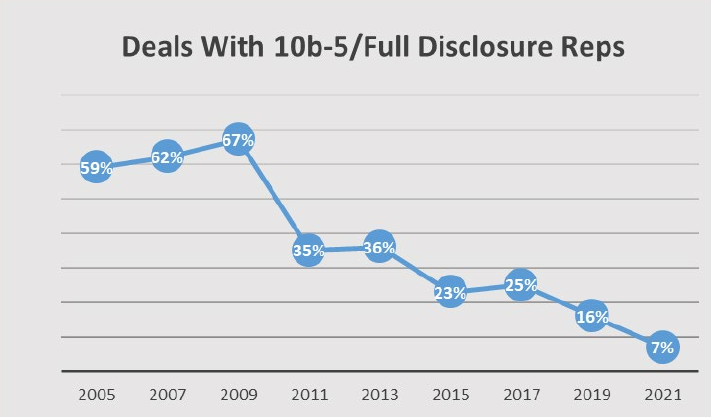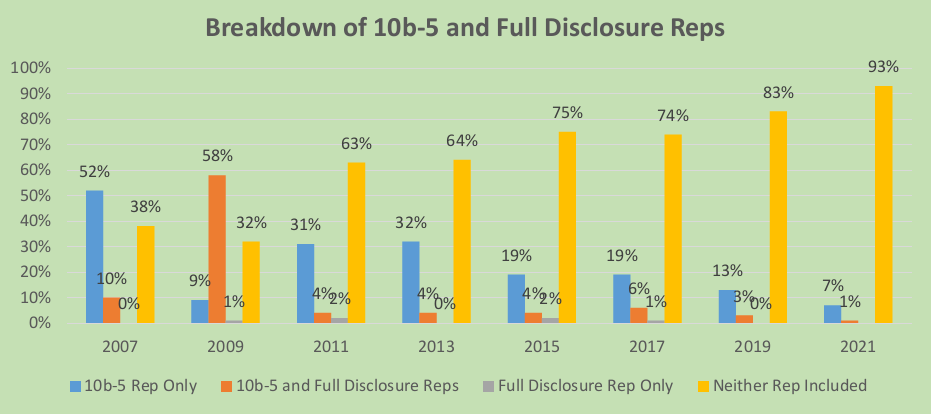Goulston & Storrs M&A attorney Dan Avery is a nationally recognized expert on M&A deal point trends. In partnership with Bloomberg Law, Dan has developed a series of 25 articles looking at these trends, on a topic-by-topic basis, providing practical insight into where these trends are heading, and the relevant implications for M&A deal professionals.
Market Trends: What You Need to Know
As shown in the American Bar Association's Private Target Mergers and Acquisitions Deal Points Studies:
- Inclusion of either 10b-5 or “full disclosure” representations in merger and acquisition purchase agreements is becoming less common, declining from a peak of 67% in the 2009 ABA study to a low of 7% in the most recent (2021) study.
- When full disclosure representations are included in mergers and acquisitions (M&A) agreements, they are almost always alongside, and rarely seen in the absence of, a 10b-5 representation.
- Over the nine ABA studies, when 10b-5 representations were included, 13% to 33% of those representations were qualified by knowledge.
- Altogether, over the past 12+ years, inclusion of a 10b-5 representation, whether with or without a full disclosure representation, has evolved from fairly common practice to an unusual occurrence.
Introduction
In M&A transactions, the definitive purchase agreement—e.g., asset purchase agreement, stock purchase agreement, or merger agreement—typically contains representations and warranties that the seller makes with respect to the target company. The scope and detail of these representations and warranties are often heavily negotiated and tailored to reflect not only the nature of the target and its business, financial condition, and operations, but also the relative negotiating strength of the buyer and seller.
One representation and warranty that the buyer often requests is commonly referred to as a “10b-5 representation.” This name is a reference to the Securities and Exchange Commission's Rule 10b-5, promulgated under Section 10(b) of the Securities Exchange Act of 1934. Clause (b) of Rule 10b-5 makes it unlawful (if using interstate commerce, the mails, or any national securities exchange), in connection with the purchase or sale of any security, to “make any untrue statement of a material fact or to omit to state a material fact necessary in order to make the statements made, in the light of the circumstances under which they were made, not misleading.” 17 C.F.R. 240.10b-5(b). Most 10b-5 representations track this language at least in part.
It's worth noting that a buyer in a private M&A stock deal may already be protected by Rule 10b-5, but including a 10b-5 representation in the purchase agreement gives the seller a contractual claim under the purchase agreement's indemnification provisions and does not require the buyer to prove the seller's knowledge of the untruth or omission, or the buyer's reliance on the same.
This article summarizes the most common formulations for 10b-5 and related full disclosure representations and examines the trends in practice with respect to these representations in private company M&A transactions.
Common Variations of 10b-5 Representations
While there are many variations of 10b-5 representations, three variations discussed here are most commonly seen in purchase agreements. Despite their differences, all three variations refer to untrue statements and statements made misleading by omission.
The “Agreement Only” 10b-5 Representation
Sample Language.
“None of the representations and warranties in Article __ of this Agreement, taking into account the Disclosure Schedules attached hereto, contain any untrue statement of a material fact or omit a material fact necessary to make each statement contained herein or therein, in light of the circumstances in which they were made, not misleading.”
Buyer's counsel will advise buyer that this type of 10b-5 representation is intended to catch any issues or matters that would otherwise fall through the cracks and not be picked up by the more specific representations and warranties elsewhere in the agreement. Though the least pro-buyer of the three, seller's counsel will resist including even this iteration of a 10b-5 representation, and may even instead push for a separate provision commonly found in M&A purchase agreements—the “no implied representations” provision.
The “no implied representations” representation is considered a pro-seller provision which states that the only representations and warranties being made in connection with the transaction are those within the purchase agreement and perhaps other identified closing documents, and/or that the buyer is not relying on any representations and warranties other than those in the transaction documents. The choice of provision to be included depends on the relative negotiating strength of the parties.
Observations.
A seller may reasonably argue that when referring only to statements in the purchase agreement the “untrue statement” portion of a 10b-5 representation is circular. If a representation in the agreement contains an untrue statement of material fact, as referenced in the 10b-5 representation, then it's hard to imagine how the representation referred to has not been breached in the first instance. The statements in a representation or warranty are either correct or incorrect, which seems logically the same as being true or untrue. In other words, a negotiated representation related to a particular topic stands on its own with respect to the truthfulness of statements contained therein, and therefore, a seller would argue, such a 10-b representation – – or at least the “untrue statement” portion of the 10b-5 representation – – adds nothing that is not already addressed within the agreement.
The value to the buyer of this “agreement only” 10b-5 representation, if any, is therefore due to the misleading by omission aspect, which arguably adds an additional standard that may be broader than a true or untrue standard. However, it is difficult to imagine how a specific representation, with or without related disclosures, could be true and correct, i.e., not breached, and yet still be misleading.
If an environmental problem at the target arises or is discovered following the closing of the transaction, and that issue is not contrary to the environmental representation in the purchase agreement, which is often heavily negotiated, does that problem amount to an “omission” that has made the relevant environmental representation misleading? How is that the right result if the buyer is a sophisticated party negotiating the topic-oriented representations and warranties?
The “Agreement and Related Materials” 10b-5 Representation
Sample Language.
“None of the representations or warranties in this Article ___ nor any of the Exhibits or Schedules attached hereto, nor any of the certificates delivered pursuant to Section ___, contain any untrue statement of a material fact or omit a material fact necessary to make each statement contained herein or therein, in light of the circumstances in which they were made, not misleading.”
Observations.
This variation of the 10b-5 representation contains the same circularity problems discussed in the agreement-only variation insofar as it covers the truthfulness of the statements made in other representations and warranties in the purchase agreement. However, unlike the agreement-only variation, it goes beyond the purchase agreement's representations and warranties to apply to any closing certificates and schedules or exhibits attached to the purchase agreement.
This broadens the scope of the representation considerably and even covers materials such as company promotional materials attached to a disclosure schedule, which is not unusual. Conceptually, this makes sense as it is easy to understand how sales or other promotional materials might be found to be misleading by omission of a material fact even if a negotiated representation or warranty in the principal agreement is not breached.
The “Transaction Related” 10b-5 Representation
Sample Language.
“No representation or warranty or other statement made by Seller or any Shareholder in this Agreement, the Disclosure Schedules attached hereto, the certificates delivered pursuant to Section ___ or otherwise in connection with the Contemplated Transactions contains any untrue statement of material fact or omits to state a material fact necessary to make the statements in this Agreement, in light of the circumstances in which they were made, not misleading.”
Observations.
This variation of the 10b-5 representation is the broadest, and most pro-buyer, of the three. It is also the variation reflected in the ABA Model APA, though, in the author's experience, is not commonly seen in practice. Significantly, this version covers not only representations and warranties, but also any statements within closing certificates or schedules (including attachments), and any statements that the seller makes in connection with the transactions.
This last point is critical because by its terms the representation is not limited to the four corners of the transaction documents but arguably includes statements made during business meetings, management presentations, due diligence production, conference calls, and otherwise.
Knowledge Qualifiers in 10b-5 Representations
10b-5 representations generally do not include knowledge qualifiers—i.e., they are given as “flat” representations. Over the nine ABA studies, 10b-5 representations were knowledge qualified in 13 to 33% of the transactions reviewed. Thus, although knowledge-qualified 10b-5 representations are included in some purchase agreements, their use is somewhat limited in practice, on a fairly consistent basis over time.
Relationship of 10b-5 & Full Disclosure Representations
10b-5 representations are often discussed in connection with full disclosure representations, though the two are different in approach and focus. The following is an example of a full disclosure representation, as set forth in the ABA Model APA:
Seller does not have Knowledge of any fact that has specific application to Seller (other than general economic or industry conditions) and that may materially adversely affect the assets, business, prospects, financial condition or results of operations of Seller that has not been set forth in this Agreement or the Disclosure Letter.
A full disclosure representation is highly buyer-oriented, and relatively rare, particularly in the absence of an accompanying 10b-5 representation.
Another version of a full disclosure representation, arguably narrower in scope than the representation above, focuses on the buyer's due diligence checklist and may appear as: “Seller has provided to the Buyer all information and materials responsive to the Buyer's due diligence checklist attached hereto as Schedule ___.” This representation may be appropriate where there is reason for the buyer to have concerns with the sellers’ disclosures or the disclosure process, and may focus the seller on the specific diligence checklist responses.
Trends in Usage of 10b-5 & Full Disclosure Representations
Every other year since 2005 the ABA has released its Private Target Mergers and Acquisitions Deal Points Studies. The ABA studies examine purchase agreements of publicly available transactions involving private companies. These transactions range in size but are generally considered as within the “middle market” for M&A transactions; the transaction values of the 123 deals within the 2021 study ranged from $30 to $750 million.
According to the ABA studies, inclusion of either 10b-5 or full disclosure representations is becoming less common, decreasing from a peak of 67% in the 2009 ABA study to a low of 7% in the most recent (2021) study. When full disclosure representations are included, they are almost always alongside, and rarely seen in the absence of, a 10b-5 representation.
Over the past 12+ years, inclusion of a 10b-5 representation, whether with or without a full disclosure representation, has evolved from fairly common practice to a highly unusual occurrence.
The following two graphs show this information in more detail.
GRAPHIC—Source: ABA Private Target Mergers and Acquisitions Deal Points Studies


GRAPHIC—Source: ABA Private Target Mergers and Acquisitions Deal Points Studies


Conclusion
There has been a pronounced decline in the inclusion of 10b-5 and full disclosure representations in private company M&A transactions. As discussed above, the different variations of these representations significantly impact risk allocation as between buyer and seller. Counsel on both sides of an M&A transaction should consider these issues carefully when negotiating 10b-5 representations.
Click here for a pdf of the article.
Reproduced with permission from Bloomberg Law. Copyright ©️2022 by The Bureau of National Affairs, Inc. (800-372-1033) http://www.bloomberglaw.com.

/Passle/630ddfd8f636e917dcf6e4ce/SearchServiceImages/2024-04-22-16-48-04-221-662694c48171a252db3820bd.jpg)
/Passle/630ddfd8f636e917dcf6e4ce/SearchServiceImages/2024-04-22-15-12-36-997-66267e64d100dba38ac045e7.jpg)
/Passle/630ddfd8f636e917dcf6e4ce/MediaLibrary/Images/2024-04-22-13-15-13-552-662662e18171a252db378c86.png)
/Passle/630ddfd8f636e917dcf6e4ce/MediaLibrary/Images/2024-04-10-02-23-24-827-6615f81c7f643c6b40a522fc.png)